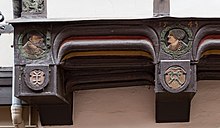Ludolf Rauschenplat
Ludolf Rauschenplat (* around 1485 in Einbeck ; † 1557 ) was a mayor of Göttingen .
In 1516 he became a member of the Göttingen merchants' guild. From 1531 he was councilor in the city. He was mayor of the city at least between 1533 and 1541 and between 1543 and 1547.
He was involved in the deliberations on the introduction of the Reformation in the city. He also supported Anton Corvinus in drafting church ordinances, which took over sections from the work of Andreas Osiander from 1533. He also took part in visitations . When Elisabeth von Calenberg wanted to raise an estimate in the area around the city in 1544 , an armed conflict threatened between her companions and the angry citizens. Rauschenplat was able to avert this with a cannon shot previously agreed with Elisabeth, whereupon she left the area and the situation calmed down. In the following years cannon shots in the area were commented on with the slogan "Rauschenplats cock crows". He was a sympathizer of Superintendent Joachim Mörlin . Mörlin was expelled from the city in 1550 by the sovereign Erich II . In 1554, Rauschenplat was driven out of the city by the town's mayor, who came from the Schwanenflügel family, and his supporters.
He came from an illegitimate branch of the Rauschenplat family, which was wealthy in several places in what is now southern Lower Saxony. The family coat of arms on this branch has two stalked leaves instead of three stalked leaves on the main branch. From 1519 he lived in the house Johannisstrasse. 6, on the facade of which the carved family coat of arms has been preserved.
According to Johannes Letzner , he was buried in St. John's Church. Mörlin had held the main service there. A drawing of Rauschenplat's grave plate has been preserved in the Lower Saxony State Archives , which was made on the occasion of a procedure before the Reich Chamber of Commerce.
Individual evidence
- ^ DIO 19 City of Göttingen (1980), No. 110a
- ↑ Albrecht Saathoff : From Göttingen's Church History, 1929, p. 142
- ^ Wilhelm Havemann : The Church Reformation of the City of Göttingen, 1842, pp. 24-29
- ^ Ludwig Adolf Petri : Agende der Hannoversche Kirchenordnung, 1852, p. 37
- ^ Emil Sehling : The Evangelical Church Orders of the XVI. Century - Lower Saxony 1st half, 1957, p. 855
- ↑ Georg Heinrich Klippel : Göttingen and his surroundings, 1824, p. 212f
- ↑ Jürgen Diestelmann : Joachim Mörlin, 2003, p. 82
- ↑ Martin Stupperich: Osiander in Preußen, 2011, p. 113
- ^ Johannes Letzner: Braunschweig-Lüneburg-Göttingensche Chronika, Third Book, p. 528
- ^ Karl Heinz Bielefeld: The Church after the Reformation, in: Dietrich Denecke , Helga-Maria Kühn (ed.): Göttingen - From the beginnings to the end of the Thirty Years' War, 1987, p. 524
| personal data | |
|---|---|
| SURNAME | Rauschenplat, Ludolf |
| BRIEF DESCRIPTION | Mayor of Göttingen |
| DATE OF BIRTH | around 1485 |
| PLACE OF BIRTH | Einbeck |
| DATE OF DEATH | 1557 |
